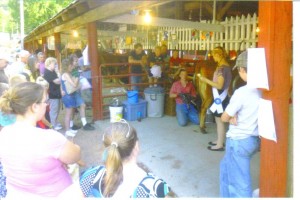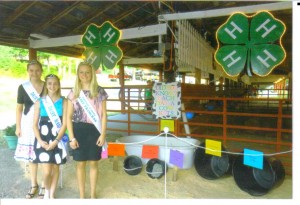 By Mackenna Bagley
By Mackenna Bagley
Sullivan County Dairy Princess
Have you ever wondered how your milk gets from the cow to your family table? On Saturday, September 1st, at the Sullivan County Fair I had the chance to demonstrate to fairgoers and explain the process. During the 5 p.m. milking time, fairgoers gathered around the brand new milking station at the recently renovated livestock barn. It was the perfect opportunity to show off the new barn feature, as well as educate many on how a cow is milked.
Helping with the demonstration was local farmer Jesse Phillips and Bella, a Jersey cow from my home farm, who was making an appearance at the fair for the week. I would like to share with you the information I shared with the crowd as Jesse and Bella went through the process.
“Dairy farmers work day in and day out to make sure you get a good quality and nutritious product. They work 24/7, 365 days a year, with little time for vacations or free time. They truly are one of America’s hardest working people. A big part of their time is devoted to milking their cows. Farmers milk two to three times a day, every day and here is how it is done.
First gloves are put on to ensure no germs from human hands come in contact with the udder of the cow. Next, the udder is sanitized with a sanitizing solution to clean the teats so no harmful bacteria will touch the milk. After a few seconds the solution is wiped off with a disposable towel. The machine used to milk a cow is called a milker. The machine gently removes the milk that is stored in the cow’s udder. The center part is called the milking claw and attached to that are four parts called infl ations, one for each teat. Each infl ation is put on the four teats and using a vacuum to create suction, it extracts the milk. The amount of time it takes to remove the milk depends on the cow and how much milk she is producing but on average it is around two to fi ve minutes.
 The milk goes from the milking unit into a hose which is connected to a pipe, called a pipeline, which carries the milk into a big milk tank where it is cooled and kept at a temperature of 40 degrees. When the cow is done being milked, the milker is taken off and the teats get sanitized again. The cow is finished for now but will get milked again in another eight to twelve hours. The milk from all of the cows on the farm goes into the tank where it is picked up on either a daily or every other day basis. When picked up, the truck driver is responsible for taking a milk sample to make sure the milk is safe from bacteria. If it is safe, it is loaded and hauled to the milk plant where milk will go through 17 tests to ensure it is safe to consume and free from any harmful substances. In the milk plant, milk is pasteurized, which means it is warmed to a very high temperature and quickly cooled to remove any harmful contaminants, and makes it even safer. After that, milk is either bottled or made into different dairy products such as cheese and yogurt, then it is hauled to the grocery store where you, the consumer, will buy it.
The milk goes from the milking unit into a hose which is connected to a pipe, called a pipeline, which carries the milk into a big milk tank where it is cooled and kept at a temperature of 40 degrees. When the cow is done being milked, the milker is taken off and the teats get sanitized again. The cow is finished for now but will get milked again in another eight to twelve hours. The milk from all of the cows on the farm goes into the tank where it is picked up on either a daily or every other day basis. When picked up, the truck driver is responsible for taking a milk sample to make sure the milk is safe from bacteria. If it is safe, it is loaded and hauled to the milk plant where milk will go through 17 tests to ensure it is safe to consume and free from any harmful substances. In the milk plant, milk is pasteurized, which means it is warmed to a very high temperature and quickly cooled to remove any harmful contaminants, and makes it even safer. After that, milk is either bottled or made into different dairy products such as cheese and yogurt, then it is hauled to the grocery store where you, the consumer, will buy it.
Throughout this whole process milk is never touched by human hands and undergoes many tests to ensure it is safe. You, the consumer, can be assured your milk comes from a good place.”
After Bella was done being milked the Sullivan County Alternate Dairy Princess Heather Fitzgerald and Dairy Maids Elizabeth Fluck and Maranna Nitcznksi handed out stickers and magnets to the crowd with the slogan “Your milk comes from a good place!”. The crowd was then allowed to ask questions. There were some really good questions! One was “How long does it take for milk to reach the consumer?” The answer is 72 hours. Another question was “How much does a cow eat?”. Luckily I was able to have a nearby display I had set up at the entrance to the barn on that very same topic.
I hope you, too, have learned how milk gets from the cow to your table. And if you are a dairy farmer who already knows this process, I hope you are pleased that we have promoted your product and ensured consumers that their “milk comes from a good place”.